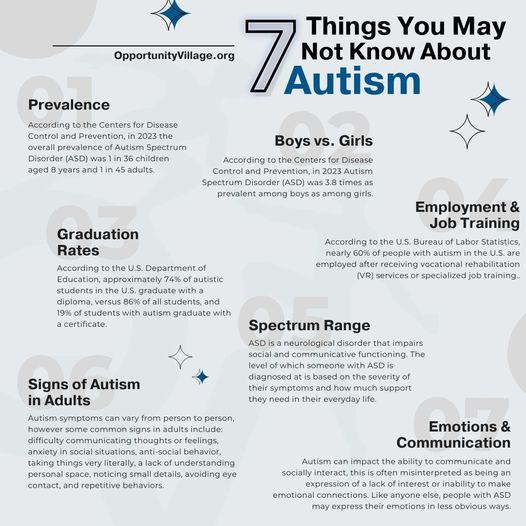
Autism spectrum disorders are diverse, they’re complex, and they can be vastly different from person to person. For families, caregivers, and people with autism, learning some facts about autism can work to demystify the condition and create a clearer picture regarding what autism is and what it may look like through different periods in a person’s life.
Prevalence of Diagnosis In The U.S.
Researchers first began tracking the prevalence of autism in the United States in 2000. The steep rise in diagnosis rates have sparked something of a belief regarding an autism “epidemic”, but are numbers really rising – or have they been there all along?
There is no physical test or scan that can detect the presence of autism. Instead, diagnosis is made through behavioral tests and observations. As researchers have learned more about autism since the year 2000, they’ve become more adept at diagnosing it and noticing symptoms in different individuals. It’s important to remember that autism spectrum disorder (or ASD) is just that – a spectrum – and criteria may be different from person to person.
Experts widely believe that there is no “uptick” in autism prevalence and that the rise in diagnosis rates is actually a direct result of learning more about the disorder and how to diagnose it as a whole. More individuals are being diagnosed correctly with ASD, and therefore more people are able to obtain the support and care they need to live their lives to the fullest.
According to the Centers for Disease Control and Prevention, the overall prevalence of ASD in children in the United States was around 1 in 36, and for adults around 1 in 45 as of 2023.
High School Graduation Rates
The high school graduation rate for students with autism is approximately 74% according to the U.S. Department of Education. This means that out of every 100 students with autism in American high schools, 74 of them will graduate with a diploma.
Improved diagnosis and research in recent years has figured out more facts about autism and has helped students to be better equipped to graduate high school when compared to previous years. According to the Organization for Autism Research, 62% of students with disabilities earned a high school diploma during the 2012-2013 academic year. As resources improve, so does the support and the outlook for today’s young people with autism and their futures.
Boy vs. Girl Diagnosis Rates
According to research performed by the Centers for Disease Control and Prevention, an autism diagnosis is significantly more prevalent in boys than in girls. As of 2023, boys are nearly four times more likely to be diagnosed with autism when compared to girls of the same age.
Scientists have not yet figured out why autism is more prevalent in boys than in girls, but some hypothesize it may have something to do with neurobiological mechanisms of sexual differentiation and their development in utero.
Opportunity Village offers screening services for children, both boys and girls, whose parents or caregivers suspect a potential ASD diagnosis.

Autism Spectrum Range
An important part of Autism Spectrum Disorder is spectrum. ASD is a neurobiological disorder that impacts the social and communicative functioning or ability. For some, the impact is greater, and for others, the impact is less. The level of impact ASD has on their functioning, and the symptoms this causes, will determine where a person falls on this “spectrum” and how much support they may need throughout their everyday life.
The impact symptoms have on a person with autism, and how this affects their support needs, is often categorized into three levels:
· Level One – People within level one may require some support, they often benefit from therapy or life skills coaching, they may experience stress during transitions, and they could show rigid behavior.
· Level Two – Those considered to be level two require more substantial support. Level two individuals may exhibit atypical social behaviors, noticeable stress during times of change, and they may require special accommodation at school.
· Level Three – Level three individuals will require very substantial support throughout their everyday lives. They may show severe communication deficits, they may require one-on-one help in education settings and alternative communication tools, and they may experience periods of extreme distress when stressed or switching tasks.
Signs Of Autism In Adults
The symptoms of autism are highly individual both in children and in adults. Most people with autism today are diagnosed as children, and this is largely due to the improved knowledge experts have regarding autism compared to before tracking began in the year 2000. This means that many people are being diagnosed now in adulthood after living their lives with challenges and support needs they may not have understood at the time.
According to the Centers for Disease Control and Prevention, an estimated 2% of adults in the United States have ASD.
Signs of autism in adults may vary, but some may include:
- Difficulty communicating thoughts and feelings
- Anxiety in social situations
- Anti-social behavior
- Interpreting things literally
- Avoiding eye contact
- Repetitive behaviors
Emotions And Communication Differences
Some of the most important facts about autism have to do with differences in emotion and communication. For those who are unaware of these differences, behaviors can easily be misinterpreted as disinterest or an unwillingness to make a social connection.
Autism impacts an individual’s ability to naturally communicate or interact socially. People with autism may show their emotions differently than neurotypical individuals, they may find it difficult to maintain eye contact, or they may find it difficult to interpret social cues during conversation.

Employment And Job Training
With vocational rehabilitation services or specialized job training, finding meaningful employment is within reach for many with autism. According to the U.S. Bureau of Labor Statistics, around 60% of people with autism nationwide are employed.
According to Forbes, individuals with autism can be found enjoying fulfilling careers in sectors ranging from the food and beverage service industry, to the arts, to information technology and everything in between.
At Opportunity Village, we offer both pre-vocational and job development and placement programs to adults with autism and other differences in ability. These programs not only help to prepare people with autism for work, but they also help them to explore fields where they can find interesting and fulfilling career paths suitable for their abilities and talents. If you are interested in learning more about these programs, contact us today.







